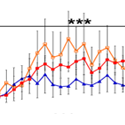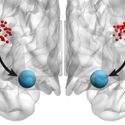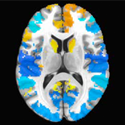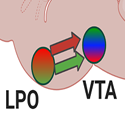Hot Off the Press – April 24, 2024 Published in Molecular Psychiatry by Atul Daiwile and Jean Lud Cadet, et al. from the NIDA IRP Molecular Neuropsychiatry Section. Summary Methamphetamine also called METH, crank, ice etc. is a powerful stimulant that has caused addiction in a lot of people in the world. Humans who take… [Read More]
Hot off the Press
Different Effects of Peer Sex on Operant Responding for Social Interaction and Striatal Dopamine Activity
Hot Off the Press – April 18, 2024 Published in The Journal of Neuroscience by Jonathan Chow, Kayla Pitts and Yavin Shaham, et al. from the NIDA IRP Neurobiology of Relapse Section. Summary Recent studies have shown that when rats are given a mutually exclusive choice between social interaction with a peer and an addictive… [Read More]
Midbrain signaling of identity prediction errors depends on orbitofrontal cortex networks
Hot Off the Press – April 10, 2024 Published in Nature Communications by Qingfang Liu and Thorsten Kahnt, et al. from the NIDA IRP Learning and Decision-Making Unit. Summary In this study, Qingfang Liu (Research Fellow in the LDMU) and colleagues show that identity prediction errors in the dopaminergic midbrain are computed based on outcome… [Read More]
GPR55 is expressed in glutamate neurons and functionally modulates drug taking and seeking in rats and mice
Hot Off the Press – April 4, 2024 Published in Translational Psychiatry by Yi He, Hui Shen and Zheng-Xiong Xi, et al. from the NIDA IRP Addiction Biology Unit and Magnetic Resonance Imaging and Spectroscopy Section. Summary G protein-coupled receptor 55 (GPR55) is a putative cannabinoid receptor, which has been considered as the “CB3” receptor, as… [Read More]
µ-Opioid receptor antagonism facilitates the anxiolytic-like effect of oxytocin in mice
Hot Off the Press – March 26, 2024 Published in Translational Psychiatry by Khalin Nisbett, Leandro Vendruscolo and George Koob from the NIDA IRP Stress & Addiction Neuroscience Unit and Neurobiology of Addiction Section. Summary Nisbett et al. discovered that the anxiolytic-like (anxiety-reducing) effect of oxytocin can be modulated by the endogenous opioid system. We… [Read More]
Childhood Trauma, Emotional Awareness, and Neural Correlates of Long-Term Nicotine Smoking.
Hot Off the Press – January 30, 2024 Published in JAMA Network Open by Annika Quam and Amy Janes et al. from the NIDA IRP Cognitive and Pharmacological Neuroimaging Unit. Summary As a primary cause of preventable death, nicotine dependence remains a significant public health concern. While there are several medications that help people quit… [Read More]
Lateral preoptic area glutamate neurons relay nociceptive information to the ventral tegmental area
Hot Off the Press – October 24, 2023 Published in Cell Reports by David Barker, Shiliang Zhang and Marisela Morales et al. from the NIDA IRP. Summary The ventral tegmental area (VTA) has been proposed to play a role in pain, but the brain structures modulating VTA activity in response to painful stimuli remain unclear…. [Read More]
Lateral orbitofrontal cortex integrates predictive information across multiple cues to guide behavior
Hot Off the Press – October 2023 Published in Current Biology by Thorsten Kahnt, et al. Summary Predictive cues typically come in bunches and combining their predictions may improve behavior. Yet, we know almost nothing about how people process reward predictions from multiple cues as well as the brain mechanisms that are involved. Our manuscript… [Read More]
High-precision mapping reveals the structure of odor coding in the human brain
Hot Off the Press – September 2023 Published in Nature Neuroscience by Thorsten Kahnt, et al. Summary Odorous molecules evoke distributed patterns of activity in olfactory cortices but how these patterns map onto inherently subjective odor percepts has remained unclear. In this study, Sagar and colleagues addressed this question by collecting high-resolution neural and perceptual… [Read More]
PPARα and PPARγ are expressed in midbrain dopamine neurons and modulate dopamine- and cannabinoid-mediated behavior in mice
Hot Off the Press – August 28, 2023 Published in Molecular Psychiatry by Briana Hempel and Zheng-Xiong Xi, et al. of the NIDA IRP Addiction Biology Unit. In this research paper, Briana Hempel et al. investigated the role of peroxisome proliferator-activated receptors (PPARs) in the CNS effects of cannabinoids. The study focuses on two specific… [Read More]










